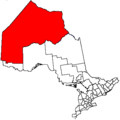Sabaskong Bay 35F | |
|---|---|
| Sabaskong Bay Indian Reserve No. 35F | |
| Coordinates: 49°08′N94°04′W / 49.133°N 94.067°W | |
| Country | |
| Province | |
| District | Kenora, Rainy River |
| First Nation | Ojibways of Onigaming |
| Area | |
| • Land | 5.18 km2 (2.00 sq mi) |
Sabaskong Bay 35F is a First Nations reserve [1] on Lake of the Woods, straddling the border of Kenora District and Rainy River District in Ontario, Canada. It is one of the reserves of the Ojibways of Onigaming First Nation.


